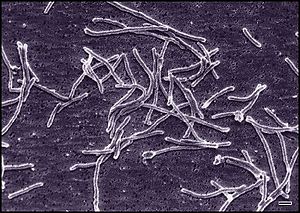Thermus aquaticus
| Thermus aquaticus | |
|---|---|
 |
|
| Scientific classification | |
| Domain: | Bacteria |
| Phylum: | Deinococcus–Thermus |
| Class: | Deinococci |
| Order: | Thermales |
| Family: | Thermaceae |
| Genus: | Thermus |
| Species: | T. aquaticus |
| Binomial name | |
|
Thermus aquaticus Brock & Freeze, 1969 |
|
Thermus aquaticus is a species of bacteria that can tolerate high temperatures, one of several thermophilic bacteria that belong to the Deinococcus–Thermus group. It is the source of the heat-resistant enzyme Taq DNA polymerase, one of the most important enzymes in molecular biology because of its use in the polymerase chain reaction (PCR) DNA amplification technique.
When studies of biological organisms in hot springs began in the 1960s, scientists thought that the life of thermophilic bacteria could not be sustained in temperatures above about 55 °C (131 °F). Soon, however, it was discovered that many bacteria in different springs not only survived, but also thrived in higher temperatures. In 1969, Thomas D. Brock and Hudson Freeze of Indiana University reported a new species of thermophilic bacteria which they named Thermus aquaticus. The bacterium was first discovered in the Lower Geyser Basin of Yellowstone National Park, near the major Great Fountain Geyser and White Dome Geyser, and has since been found in similar thermal habitats around the world.
It thrives at 70 °C (158 °F), but can survive at temperatures of 50 °C to 80 °C (122 °F to 176 °F). This bacterium is a chemotroph—it performs chemosynthesis to obtain food. However, since its range of temperature overlaps somewhat with that of the photosynthetic cyanobacteria that share its ideal environment, it is sometimes found living jointly with its neighbors, obtaining energy for growth from their photosynthesis.
...
Wikipedia
